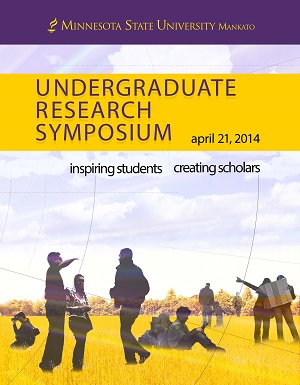Event Title
Further Examination of Formed Adducts from the Reactions of Decanal and Trans-2-Decenal with Each Nucleoside of DNA
Location
CSU Ballroom
Start Date
21-4-2014 10:00 AM
End Date
21-4-2014 11:30 AM
Student's Major
Chemistry and Geology
Student's College
Science, Engineering and Technology
Mentor's Name
Danae Quirk-Dorr
Mentor's Email Address
danae.quirk-dorr@mnsu.edu
Mentor's Department
Chemistry and Geology
Mentor's College
Science, Engineering and Technology
Second Mentor's Name
Mary Hadley
Second Mentor's Email Address
mary.hadley@mnsu.edu
Second Mentor's Department
Chemistry and Geology
Second Mentor's College
Science, Engineering and Technology
Description
Organic substances containing decanal and trans-2-decenal have been touted to potentially possess anti-cancer properties. Since it has also been reported that chemical reactions involving biological and synthetic factors often form adducts with DNA, the anti-cancer properties of decanal and trans-2-decenal may be due to formed adducts with DNA. These formed adducts could terminate cancer-causing replication in cells. The purpose of this research was to further examine the adducts that formed from the interactions of two aldehydes, decanal and trans¬2-decenal, with guanosine and explore potential reactions between these aldehydes and the nucleosides 2’-deoxyadenosine, 2’-deoxycytidine, and thymidine. Past research showed that L-arginine promotes the reactivity of aldehydes toward DNA, so it was utilized in these reactions. These reactions of the aldehydes with the each nucleoside, at 70˚C for 48 hours, were analyzed via 1H NMR and HPLC. In addition to the reactions described above, Macro-scale reactions of each aldehyde with guanosine were conducted to obtain a greater quantity of adduct for purification and structural determination. The reactions were monitored by TLC and silica gel column chromatography was used in the purification of the formed adducts. 1H NMR, HPLC, and UV spectroscopy were utilized in the partial characterization of the formed adducts. Determining the structure of the adducts formed in these reactions may give insight into the reported anti-cancer properties of these compounds.
Further Examination of Formed Adducts from the Reactions of Decanal and Trans-2-Decenal with Each Nucleoside of DNA
CSU Ballroom
Organic substances containing decanal and trans-2-decenal have been touted to potentially possess anti-cancer properties. Since it has also been reported that chemical reactions involving biological and synthetic factors often form adducts with DNA, the anti-cancer properties of decanal and trans-2-decenal may be due to formed adducts with DNA. These formed adducts could terminate cancer-causing replication in cells. The purpose of this research was to further examine the adducts that formed from the interactions of two aldehydes, decanal and trans¬2-decenal, with guanosine and explore potential reactions between these aldehydes and the nucleosides 2’-deoxyadenosine, 2’-deoxycytidine, and thymidine. Past research showed that L-arginine promotes the reactivity of aldehydes toward DNA, so it was utilized in these reactions. These reactions of the aldehydes with the each nucleoside, at 70˚C for 48 hours, were analyzed via 1H NMR and HPLC. In addition to the reactions described above, Macro-scale reactions of each aldehyde with guanosine were conducted to obtain a greater quantity of adduct for purification and structural determination. The reactions were monitored by TLC and silica gel column chromatography was used in the purification of the formed adducts. 1H NMR, HPLC, and UV spectroscopy were utilized in the partial characterization of the formed adducts. Determining the structure of the adducts formed in these reactions may give insight into the reported anti-cancer properties of these compounds.
Recommended Citation
Ranals, Neil. "Further Examination of Formed Adducts from the Reactions of Decanal and Trans-2-Decenal with Each Nucleoside of DNA." Undergraduate Research Symposium, Mankato, MN, April 21, 2014.
https://cornerstone.lib.mnsu.edu/urs/2014/poster_session_A/42



